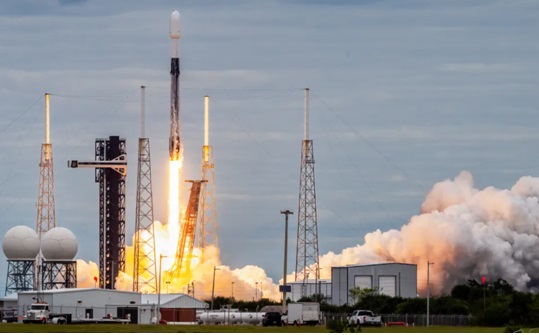Prelims: Current Affairs, Space Technology
Mains, General Studies Paper-3: Awareness regarding topics related to Information Technology, Space, Computers, Robotics, Nano-technology, Bio-technology and Intellectual Property Rights |

Reference:
Elon Musk-owned SpaceX company's 'Falcon 9' rocket successfully launched the Indian Space Research Organization (ISRO)'s GSAT-N2 satellite (artificial satellite) from Cape Canaveral, Florida on November 19, 2024.
About GSAT-N2
- What is it: A communication satellite
- It is also called GSAT-20.
- Manufactured: Developed by ISRO's Satellite Center and Liquid Propulsion Systems Center.
- Purpose: To meet India's growing connectivity needs
- Lifespan: 14 years
- Weight: 4,700 kg
- Position: Geostationary orbit (at an altitude of 35,786 km)
Key features of GSAT-N2:
- High data capacity: With a throughput (the amount of material or objects passing through a system or process) of 48 Gbps on 32 user beams, the satellite ensures robust broadband coverage that will extend service to remote areas like Andaman Nicobar and Lakshadweep islands.
- Out of the 32 user beams, 8 are Narrow Spot Beams over Northeast region and 24 are Wide Spot Beams over rest of India.
- Ka-band technology: Using Ka-band frequency, GSAT-20 is designed to support in-flight internet services and smart city initiatives.
- Durability and efficiency: The satellite is designed for a mission life of 14 years and uses advanced materials including carbon fibre polymer structures and lithium ion batteries.
- Demand-driven model: The launch is part of the Indian government's 2020 space sector reforms under which NSIL has been given the mandate to develop satellites based on service demand.
ISRO-SpaceX collaboration:
- This is the first time a satellite built by ISRO has been launched by SpaceX.
- The launch collaboration between ISRO and SpaceX aims to enhance internet services in India, including remote areas as well as in-flight connectivity.
- Historically, India has relied on French Arianespace rockets to launch heavy satellites.
- However, the 4,700 kg GSAT-20 was beyond the capacity of India's launch vehicles, forcing NSIL to choose SpaceX's Falcon 9.\
- The Falcon-9 rocket is a reusable rocket manufactured by SpaceX.
- Falcon-9 can carry satellites as well as people into space.
- Its reusability significantly reduces the cost of the company's projects.
|
About NSIL
- New Space India Limited (NSIL) is the commercial arm of ISRO.
- It was established on March 6, 2019 (under the Companies Act, 2013).
- Its primary responsibility is to enable Indian industries to undertake high-technology space-related activities.
- It is also responsible for the promotion and commercial exploitation of the products and services of the Indian space program.
- In June 2022, NSIL successfully launched its first demand-driven satellite mission GSAT-24 (now called GSAT-N1), which is fully leased to just one company, TataPlay.
- However, unlike GSAT-24, GSAT-20 will serve multiple users.
|
Implications of this launch:
- The successful launch of GSAT-N2 reflects India's emerging approach to space exploration that combines domestic expertise with global partnerships.
- The partnership with SpaceX not only begins a new chapter for NSIL but also reflects India's growing engagement with international space agencies.
- As smart cities, in-flight internet, and connectivity to remote areas become increasingly important, GSAT-20 will play a vital role in the future.



